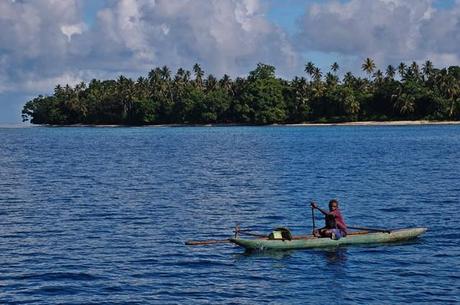En route to the Hermits, we spent more time than we originally planned at Ungalik. But we feel the need to keep moving west, to try and get as far as we can towards Indonesia’s Raja Ampat before the seasonal northwesterlies set in. Still, we couldn't resist the lure to linger a bit longer near New Hanover.
 Visitors come to Totem in all manner of flotation devices
Visitors come to Totem in all manner of flotation devices
Tunung (erroneously labeled “Dunung” on our charts) has a large WWII ship and the wreck of a submarine to find, and a great position to jump off for the ~320 nm trip to the Hermits- so off we go.
Working between New Hanover and the fringing islands, we see one sweet spot after another. Islets that look to too perfect to be real pass in our wake: white sand, palm trees, pods of dolphins. Beautiful swells curl great stretches into sandy shores; I suspect we are passing world class, barely touched surfing spots. Not to mention, the waves look less lethal than most of the dumps into the coral reefs we've seen. But it’s not all rosy behind the lush scenery, since we've been warned about theft and danger around the logging camps along the larger island, and want to pick our anchorage with care.
With the anchor down at the Three Islands Harbour island of Tunung, we dinghy in loops around the area where we believe the wrecks to be located. If there was ever a time I really wanted a fish finder or depth sounder in our dink, this would be it! We know we’re in the right place, but the ship eludes us. It doesn't help that we've started out with poor light in the back half of the afternoon, with high tide, and poor viz in the water. Just as we've pointed back towards Totem, a dugout is launched and begins paddling towards us. We motor over for hellos and meet Paul. He knows exactly where the wreck is, and takes us to the spot.
It’s magical, and somber. A large ship lying on one side, a few meters below the surface. Knowing we're over the sunken tomb of the crew feels heavy. The sides are surprisingly clean, but the biggest coral fans I've ever seen wave gently in the current. A school of large sweetlips hide inside, in the shadows of the hull. We drift silently with the current, awed on different fronts by the beauty of the marine life the knowledge of the real people who died beneath us. Back in the dinghy, we marvel over the size of the fish. I joke with Jamie about going back to catch dinner, but it doesn't feel right.
Only a handful of families live on Tunung. Many work at the small resort on shore, but it’s closed temporarily. Most of the island's children seem to be on Totem at one point in the afternoon, and they’re the quietest bunch we've met. We invite them aboard and sit in the cockpit, drinking cold juice and snacking on watermelon together. Old enough to attend school, we know they can understand some English, but they don't speak much- mostly just reacting to questions with quiet giggles and wide eyes. The junior crew on Totem is swimming around the boat, jumping off and climbing back up again like a big floating jungle gym, but they aren't able to lure the other kids into their fun.
 Paddling to school on the mainland
Paddling to school on the mainland
School is across on the “mainland”, as they refer to the island of New Hanover (only 20 miles across, but the main island from their perspective). Children paddle their dugouts daily to attend school- older children helping to ferry the youngest. There are no helicopter parents here! I look at the stretch of water, and marvel that they even make it on a regular basis. But then I think of the kids back on Panapompom, who have a long barefoot walk over a coral path (trust me, this hurts even if you have toughened feet) and then get to cross a river with crocs so that they can have the privilege of schooling. The boy paddling ahead of us has a cracker tin which probably keeps his notebook dry, and parcel woven from coconut fronds that probably holds lunch.
How soft we are.

